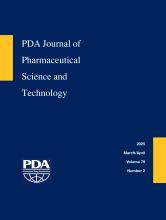Abstract
The discussion on the facility risk mitigation was included in the 2017 viral clearance symposium for the first time. There were a few topics discussed in this session, including sanitization / cleaning against viruses, viral segregation as well as definition of a functionally closed system. Virus inactivation by disinfectants is critical for the biotechnology industry. The efficacy can be different, depending whether applied to surfaces, in solutions or in the gas phases, as well as the respective disinfectants, i.e., peracetic acid - hydrogen peroxide-based, hypochlorite-based or glutaraldehyde-based. Most equipment used in biotech industry can be cleaned or sanitized by alkaline solutions. Many of these methods were studied with regard to their virus reduction potential and were defined considering alkaline concentration, time and temperature. Virus clearance may potentially be compromised if cross contamination or carryover happens, from an early step with potentially a higher level of virus to a step later in the purification process, i.e., after virus removal or inactivation. Critical potential carryover (Vcpc) is defined as the volume of carryover that will significantly affect the overall virus clearance of a purification process. Based on the evaluation of critical potential carryover, mitigation actions can be introduced to avoid such carryover. Appropriate segregation within manufacturing facilities is required by regulators and utilized by manufacturers to ensure that the final product has appropriate safety margins. However, there is a lack of consensus around basic definitions and approaches related to facility segregation. To address this gap, the member companies of the Consortium on Adventitious Agent Contamination in Biomanufacturing (CAACB) have begun a project with the goal of developing a definition for a "functionally closed" manufacturing system.
- Received June 22, 2018.
- Accepted June 28, 2018.
- Copyright © 2018, Parenteral Drug Association
PDA members receive access to all articles published in the current year and previous volume year. Institutional subscribers received access to all content. Log in below to receive access to this article if you are either of these.
If you are neither or you are a PDA member trying to access an article outside of your membership license, then you must purchase access to this article (below). If you do not have a username or password for JPST, you will be required to create an account prior to purchasing.
Full issue PDFs are for PDA members only.
Note to pda.org users
The PDA and PDA bookstore websites (www.pda.org and www.pda.org/bookstore) are separate websites from the PDA JPST website. When you first join PDA, your initial UserID and Password are sent to HighWirePress to create your PDA JPST account. Subsequent UserrID and Password changes required at the PDA websites will not pass on to PDA JPST and vice versa. If you forget your PDA JPST UserID and/or Password, you can request help to retrieve UserID and reset Password below.






